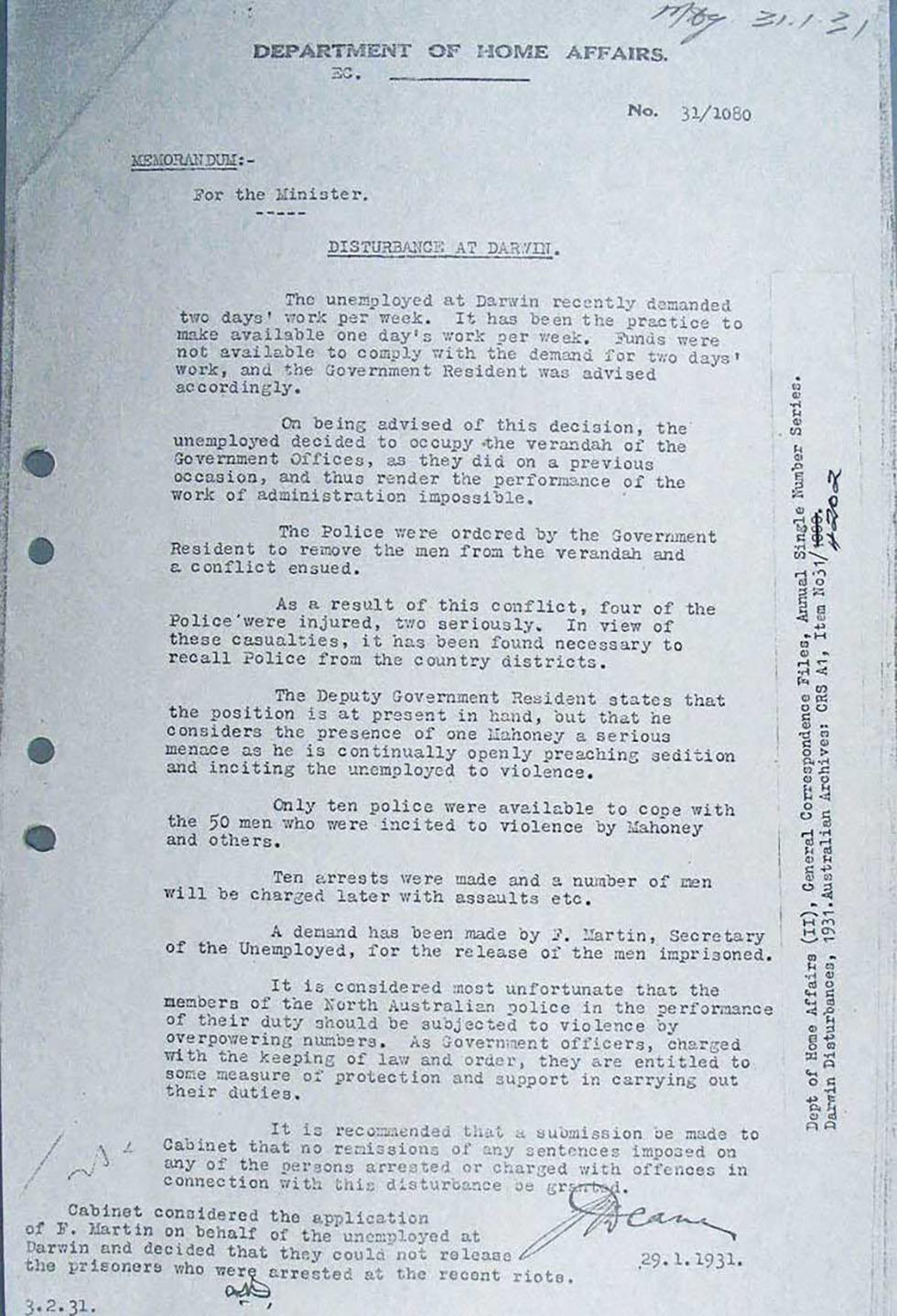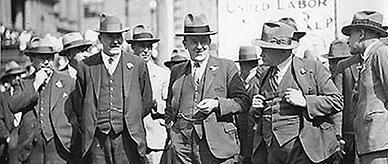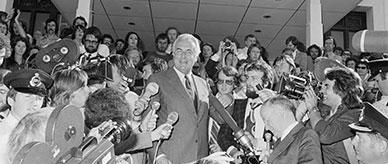


Transcript
[Illegible initials] 31.1.31
[Letterhead:] DEPARTMENT OF HOME AFFAIRS.
E.C.
No. 31/1080
MEMORANDUM:- [underlined]
For the Minister.
[dividing line]
[Underlined heading:] DISTURBANCE AT DARWIN.
The unemployed at Darwin recently demanded two days' work per week. It has been the practice to make available one day’s work per week. Funds were not available to comply with the demand for two days' work, and the Government Resident was advised accordingly.
On being advised of this decision, the unemployed decided to occupy the verandah of the Government Offices, as they did on a previous occasion, and thus render the performance of the work of administration impossible.
The Police were ordered by the Government Resident to remove the men from the verandah and a conflict ensued.
As a result of this conflict, four of the Police were injured, two seriously. In view of these casualties, it has been found necessary to recall Police from the country districts.
The Deputy Government Resident states that the position is at present in hand, but that he considers the presence of one Mahoney a serious menace as he is continually openly preaching sedition and inciting the unemployed to violence.
Only ten police were available to cope with the 50 men who were incited to violence by Mahoney and others.
Ten arrests were made and a number of men will be charged later with assaults etc.
A demand has been made by F. Martin, Secretary of the Unemployed, for the release of the men imprisoned.
It is considered most unfortunate that the members of the North Australian police in the performance of their duty should be subjected to violence by overpowering numbers. As Government officers, charged with the keeping of law and order, they are entitled to some measure of protection and support in carrying out their duties.
It is recommended that a submission be made to Cabinet that no remissions of any sentence imposed on any of the persons arrested or charged with offences in connection with this disturbance be granted.
[Handwritten signature:] P Deane
29.1.1931.
[Typed paragraph added to the bottom of the page:]
Cabinet considered the application of F. Martin on behalf of the unemployed at Darwin and decided that they could not release the prisoners who were arrested at the recent riots.
[Illegible handwritten initials]
3.2.31.
[A piece of paper has been attached to one edge of the page, reading:]
Dept of Home Affairs (II), General Correspondence Files, Annual Single Number Series.
Darwin Disturbances, 1931. Australian Archives: CRS A1, Item No 31/4202
About this record
This is a typed memorandum issued from the office of the Commonwealth Department of Home Affairs and addressed to the minister, Arthur Blakely, discussing recent demands in Darwin by unemployed workers for two days of work per week. At the time, the Northern Territory was administered by the federal government. The memo is typed on a single page with a signature at the bottom. The main body of text is dated '29.1.1931'. On the bottom left of the page is an added typed note dated '3.2.31' which has been initialled. The full signature is that of Percy Edgar Deane, a senior officer with the Department of Home Affairs.
Educational value
- This document outlines two incidents of protest and violence by unemployed workers in Darwin during the Great Depression of the 1930s, a period when unemployment in Australia peaked at almost 32 per cent. The memorandum shows that more than 50 men were involved in a protest on the verandah of the government offices. The demonstration turned violent after the police were called, leading to ten arrests. Blame was laid on a man named Mahoney, who it was alleged had incited the others to violent protest.
- The Great Depression exacerbated Australia's already high unemployment. With no national unemployment benefit or dole at the time, people were forced to rely on charity or on unemployment relief delivered through state-based public work programs. The Darwin protest was brought about by a lack of sufficient funds to provide two days of work per week. This was despite an additional £500,000 being released by the federal government only months beforehand.
- The disturbance is indicative of the mounting anger and dissent in Australia over the government's handling of relief monies. It came at a time of severe social unrest in Australia and a rise in left-wing political organisations, including communist and socialist groups, as well as right-wing nationalist and fascist groups. Less than three weeks before this disturbance an incident had also occurred in Adelaide when unemployed workers rioted over food rations.
- This document indicates the high tensions felt within federal and state governments over social and political dissent during the early 1930s. The emotive term 'riot' is used in this official document and indicates the serious line officials was taking with public disturbances such as these. The request for no leniency to be shown to the men who had been arrested is endorsed in the added note, which states that Cabinet would not consider the release of the prisoners.
- The document is suggestive of public opinion about the unemployed, which was divided between those who saw them as being responsible for their own predicament and those who did not. People who became unemployed when a factory closed down, for example, were seen as more 'deserving' than others. Those unemployed who had not been made redundant were viewed with suspicion and thought by some to be 'slackers' who should be treated harshly.
- By 1931 men who could prove they were without employment could take part in relief work, which was the basis of the protestors' actions in Darwin. The work was organised and controlled by each individual state, with money allocated from the federal government. Although at least £2,500,000 had been allocated, it was far from sufficient in meeting the demands of the unemployed, who reacted to the shortfall with sometimes angry protests.
Acknowledgments
Learning resource text © Education Services Australia Limited and the National Archives of Australia 2010.
Related themes
Need help with your research?
Learn how to interpret primary sources, use our collection and more.


